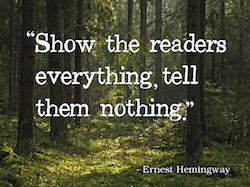4.1 Read About
4.1D Show Don't Tell - Journey to the Fishing Grounds

Today, you will be reading and responding to a poem that shows everything and tells very little. Then, you will be a creative thinker and write your own a poem, using vivid imagery.
What is the secret to "showing" a scene? Use imagery to create a picture. Here's how:
- Specific details.
- Sensory details - sights, hearing, touch, or even taste or smells.
- Strong action verbs. (looms, winding, pedaled, sought, absorbed, lapping, hummed)
- Creatively applied adverbs. (menacingly, casually, reluctantly, seemingly)
- Interesting nouns.
- Tantalizing adjectives! (majestic, grass-filled, endless, fairyland, gentle, peaceful, salty)
These details breathe life into your writing and project the reader into the scene to become a part of it.
Do you have a favourite view? Do you have an activity that makes you think of certain smells and sounds? Or do you have a concept (like creativity) that can be described using sensory details?
In this lesson, you will visit another "show, don't tell" poem. Then you will try to write one of your own.
"Statl’limx Fishing: Night Air", was written by a First Nations' author who writes about connections to the land and creatures on it. If you've ever been to a First Nations' longhouse, Pow Wow, canoe race, or other event, you have probably tried smoked salmon - the subject of this poem.
 |
Complete the reading and responses as explained in the Learning Guide. Then return to this online lesson. |
Where Will You Journey Today?
Do you have a favourite place?
- A place where you feel at peace or are amazed at the splendour?
- A place your family has traveled to?
- An Okanagan beach?
- A Rocky Mountain retreat?
- Camping in Parksville?
- A ranch in the Cariboo region of BC?
- Even a waterslide or waterfall would be great choices!
Do you fancy somewhere exotic?
- A beach on Hawaii?
- A hike to ancient ruins?
- A country you've read about in social studies or seen in a documentary?
1. When you know what poetic journey you'd like to take your audience on, if possible, find a picture of that place (or even visit it if it is in your neighbourhood).
You know your purpose: To take the reader on a journey to _____________________, so let's go!.
Record your purpose in your Learning Guide and then continue the prewriting process:
2. Brainstorm words that describe your chosen location.
 |
Go to your Learning Guide now and follow the steps to unleash your creativity and "show, don't tell" abilities. Then, complete the "Poetry Reading Quiz". |